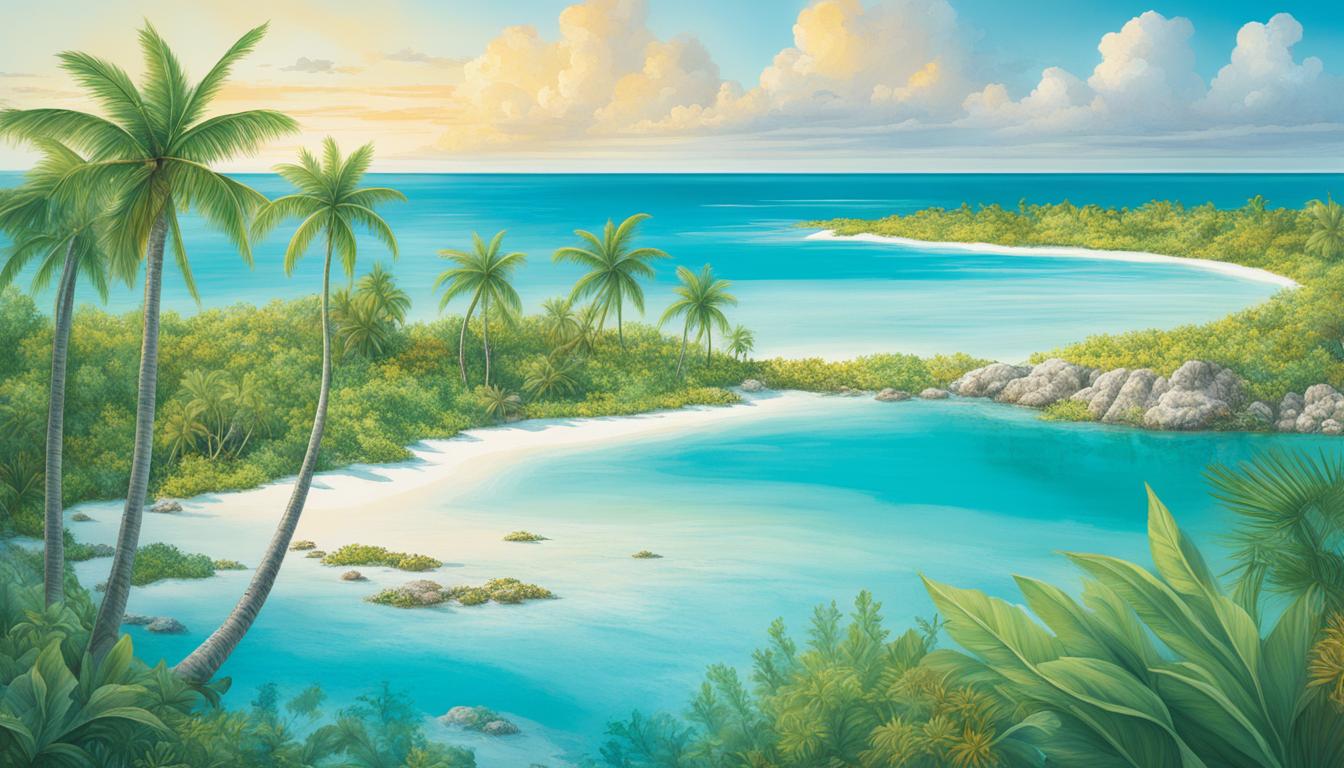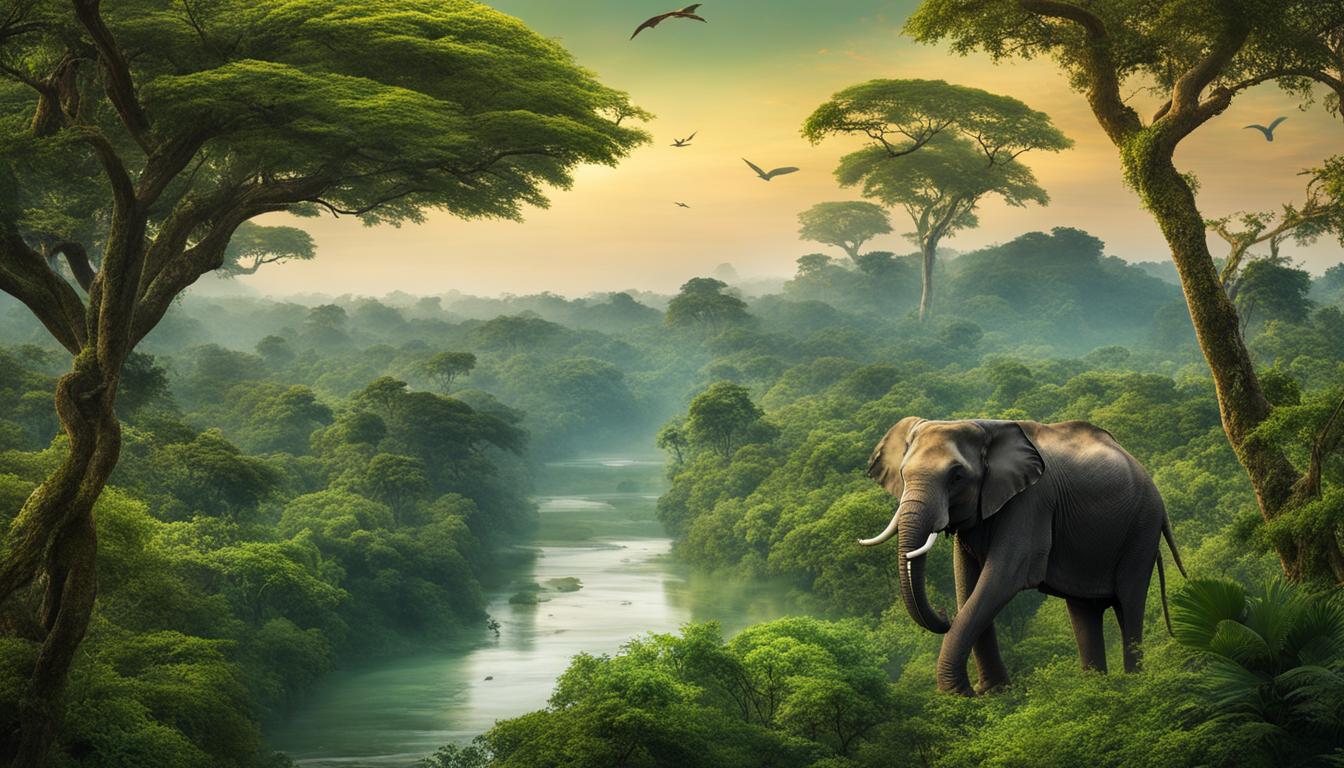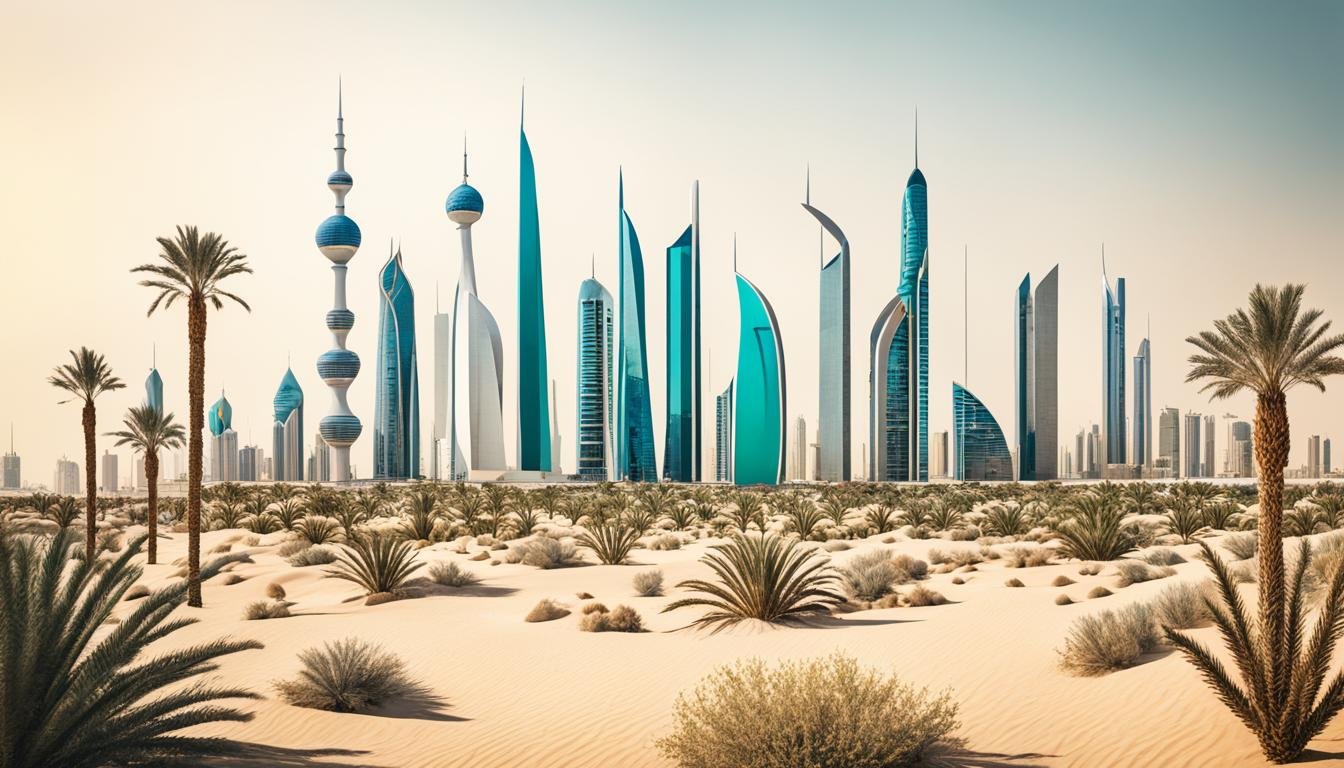Bahrain Sacred Natural Sites and Biodiversity
Welcome to Bahrain, a country in the Arabian Gulf that is home to a remarkable secret. Did you know that this Middle Eastern nation boasts a diverse ecosystem and is considered a biodiversity hotspot? With its sacred natural sites and abundant flora and fauna, Bahrain is a treasure trove of cultural heritage and environmental wonders. Let’s delve into the fascinating world of Bahrain’s sacred natural sites and biodiversity and explore the importance of conservation and environmental protection.
Key Takeaways:
- Bahrain is a hotspot for biodiversity, boasting sacred natural sites and a diverse ecosystem.
- The country faces threats to biodiversity due to urbanization, pollution, and habitat loss.
- Efforts are being made to protect and preserve Bahrain’s natural wonders through conservation measures.
- The Tree of Life, a symbol of resilience, is a popular tourist attraction in Bahrain.
- Conservation challenges and the promotion of sustainable tourism are key priorities for Bahrain’s environmental future.
The Importance of Biodiversity in Bahrain
Bahrain boasts exceptional biodiversity that holds international significance. One notable area is the Hawar Islands Protected Area, which serves as vital habitation and breeding grounds for migratory seabirds, including the world’s largest Socotra cormorants nesting site. Additionally, the marine environment supports threatened species like dugongs and green turtles, who depend on sea grass beds for sustenance. However, the biodiversity in Bahrain faces formidable challenges posed by urbanization, industrial and oil pollution, overfishing, and the invasion of non-native species.
Despite the threats, conservation efforts focusing on the preservation and sustainable use of biodiversity are crucial. By implementing strategies for environmental protection and advocating for conservation, Bahrain can mitigate the impact of these challenges and ensure the long-term survival of its diverse ecosystems.
Protected Areas in Bahrain
Bahrain boasts several protected areas that play a crucial role in conserving its diverse ecosystems. These protected areas serve as havens for rare and threatened species, safeguarding their habitats and ensuring their long-term survival.
Terrestrial Protected Area: Al-Areen Wildlife Park and Reserve
The Al-Areen Wildlife Park and Reserve is Bahrain’s sole terrestrial protected area. Spanning over 8 square kilometers, this sanctuary is dedicated to the conservation of a variety of animal and plant species. It provides a safe refuge for breeding populations of rare and endangered animals, including Arabian gazelles, Arabian oryxes, and sand gazelles.
Marine Protected Areas: Preserving Bahrain’s Underwater Treasures
Bahrain takes pride in its commitment to protecting its marine environments, recognizing the vital role they play in the country’s biodiversity. There are currently five marine protected areas, each contributing to the preservation of Bahrain’s underwater treasures.
- Hawar Islands Protected Area: The Hawar Islands, designated as a RAMSAR site, are of immense importance as a breeding area for seabirds. This protected area safeguards the islands’ fragile ecosystem and contributes to the conservation of migratory bird species.
- Other Marine Protected Areas: These include the Tubli Bay, Sitra, Dar Islands, and the northern coastal region. These protected areas focus on the preservation of delicate marine habitats, such as coral reefs, sea grass beds, and expansive mangrove forests.
By designating these marine protected areas, Bahrain recognizes the need to sustainably manage and conserve its marine resources, working towards a harmonious coexistence between human activities and the natural environment.
“Our marine protected areas act as guardians of Bahrain’s diverse marine ecosystems, ensuring the continued thriving of marine life and the preservation of precious natural habitats.” – Marine Environmentalist
In addition to protecting endangered species and safeguarding fragile ecosystems, these protected areas serve as important educational and recreational resources for both locals and tourists. They offer opportunities for scientific research, environmental education, and sustainable eco-tourism activities.
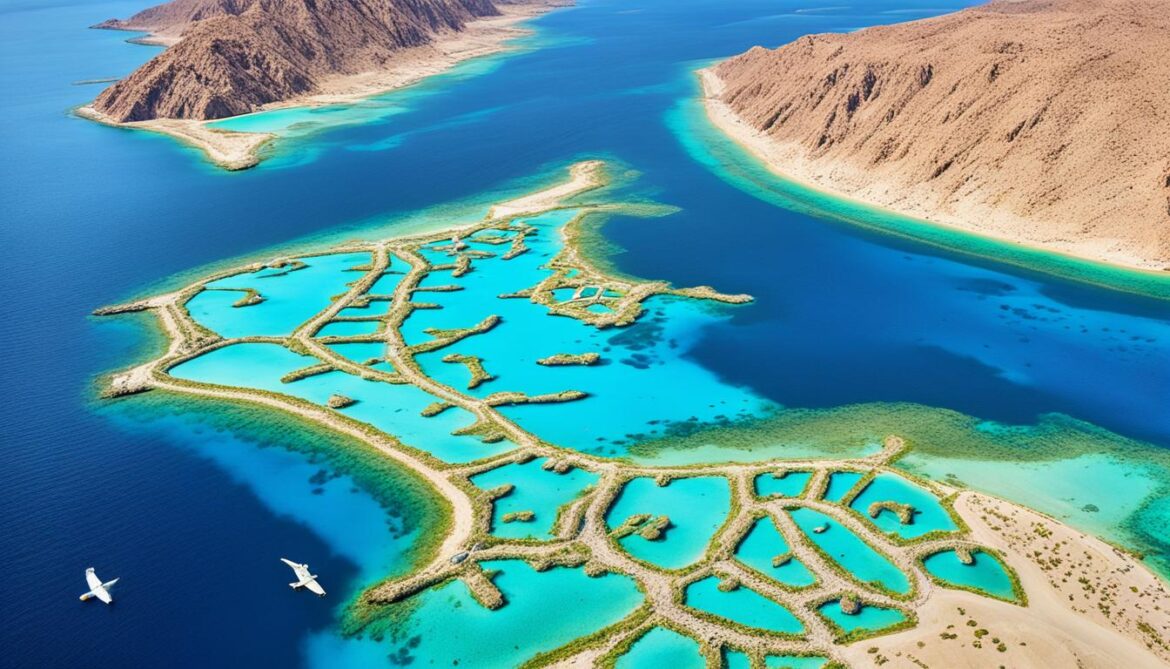
| Protected Areas | Terrestrial Protected Area | Marine Protected Areas |
|---|---|---|
| Number of Protected Areas | 1 | 5 |
| Protected Area Name | Al-Areen Wildlife Park and Reserve | Hawar Islands Protected Area Tubli Bay Sitra Dar Islands Northern Coastal Region |
| Main Objective | Conservation of terrestrial species and habitats | Preservation of marine ecosystems and resources |
| Notable Features | Safe haven for rare and endangered species | Protection of breeding areas for seabirds and delicate marine habitats |
While Bahrain has successfully established these protected areas, there is still work to be done. A comprehensive protected areas system that covers all unique ecosystems within the country is needed to enhance conservation efforts and ensure the sustainable future of Bahrain’s natural heritage.
Efforts to Achieve Conservation Goals
Bahrain is committed to the conservation and sustainable use of biodiversity. A range of initiatives have been implemented to ensure the protection of natural resources and promote environmental awareness.
Biodiversity Conservation and Education
Public awareness programs have been introduced to educate the population on the importance of biodiversity and its conservation. These programs aim to instill a sense of responsibility towards the environment and encourage sustainable practices. Furthermore, biodiversity conservation has been integrated into the national educational curricula, ensuring that future generations are equipped with the knowledge and skills necessary to contribute to environmental preservation.
The National Environment Strategy
The National Environment Strategy (NES) is a comprehensive plan being considered for adoption in Bahrain. This strategy encompasses a wide range of conservation measures and policies aimed at protecting and restoring biodiversity. If implemented, the NES will provide a framework for environmental protection, promoting sustainable development and ensuring the preservation of natural resources for future generations.
Encouraging Sustainable Agriculture
The agricultural sector in Bahrain plays a vital role in promoting the sustainable use of biodiversity. Programs have been implemented to reuse treated wastewater for irrigation, reducing dependency on freshwater resources. Loans are also provided to farmers to support the protection and conservation of date palm groves, which are essential for biodiversity and cultural heritage preservation.
Minimizing Overfishing and Promoting Traditional Practices
Efforts have been made to minimize overfishing to protect marine biodiversity. Destructive fishing methods, such as blast and cyanide fishing, have been prohibited, while sustainable traditional fishing practices are promoted. These measures ensure the long-term viability of fish populations and contribute to the overall conservation of marine ecosystems.
Through these initiatives, Bahrain is actively working towards achieving its conservation goals. By promoting public awareness, implementing sustainable practices, and developing comprehensive strategies, the nation is committed to the preservation and sustainable use of its biodiversity.

The Tree of Life – A Symbol of Resilience
The Tree of Life, locally known as Shajarat-al-Hayat, is a 400-year-old tree located in Jebel Dukhan, the highest point in Bahrain. What makes this tree remarkable is its ability to survive in the harsh and hostile desert environment with minimal rainfall. Scientists have not been able to unravel the mystery behind its resilience. Some theories suggest that the tree’s roots are deep enough to access water or that it has adapted to extract moisture from sand grains. The Tree of Life is considered a symbol of endurance and has become a top natural wonder and attraction in Bahrain.
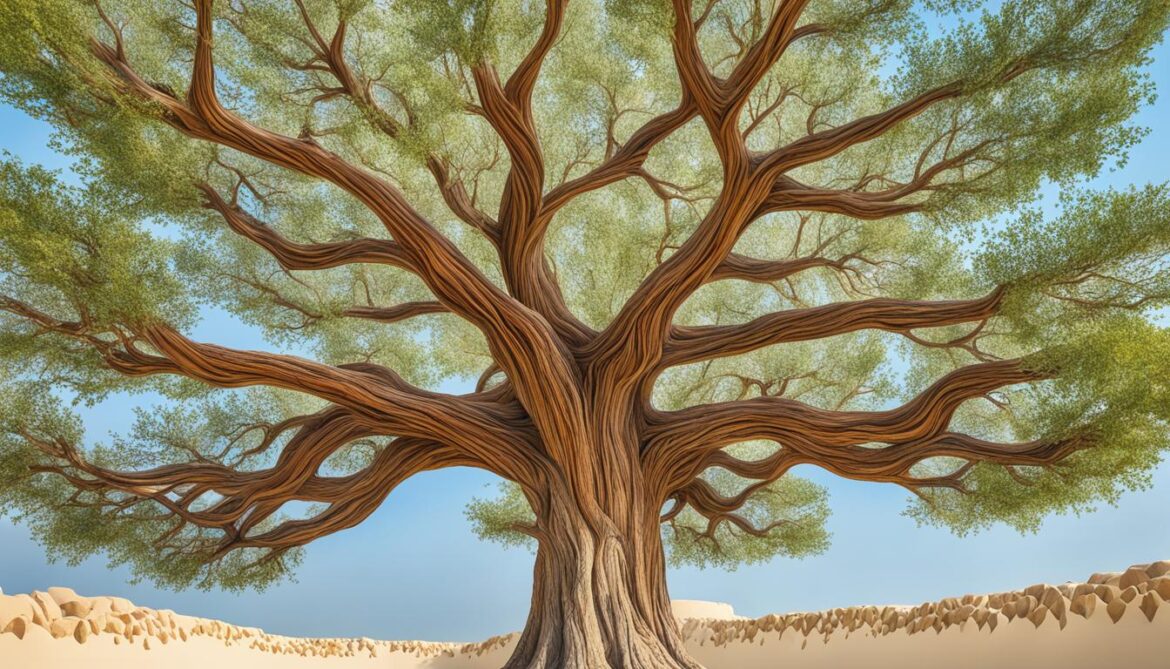
| Tree of Life – Jebel Dukhan | Symbol of Endurance |
|---|---|
| Age | 400 years |
| Location | Jebel Dukhan, Bahrain |
| Environment | Harsh desert with minimal rainfall |
| Theories | Deep roots or moisture extraction from sand grains |
| Significance | Symbol of endurance and natural wonder |
Myths and Legends Surrounding the Tree of Life
The Tree of Life in Bahrain has captured the imagination of many, giving rise to a plethora of myths and legends. One such belief is that the tree stands on the very spot where the Garden of Eden once flourished, making it an integral part of biblical lore. The association with the Garden of Eden has led some to speculate that the Tree of Life possesses a mystical source of water, granting it the ability to survive in an arid environment.
The exact reason behind the tree’s resilience in the face of harsh conditions remains a mystery, adding to its intrigue and allure. Scientists and researchers have yet to unravel the secrets that enable the Tree of Life to thrive in the Arabian Desert with minimal rainfall. Some theories suggest that its extensive root system allows it to access water deep beneath the surface, while others propose that it has adapted unique mechanisms to extract moisture from the surrounding sand grains.
“The Tree of Life stands as a testament to nature’s mysteries and the resilience of life itself.”
Local communities in Bahrain hold the Tree of Life in high regard, considering it sacred and attributing supernatural qualities to its existence. The tree’s endurance in such an unforgiving environment has fostered immense faith and reverence among the locals, who continue to draw inspiration from its remarkable survival.
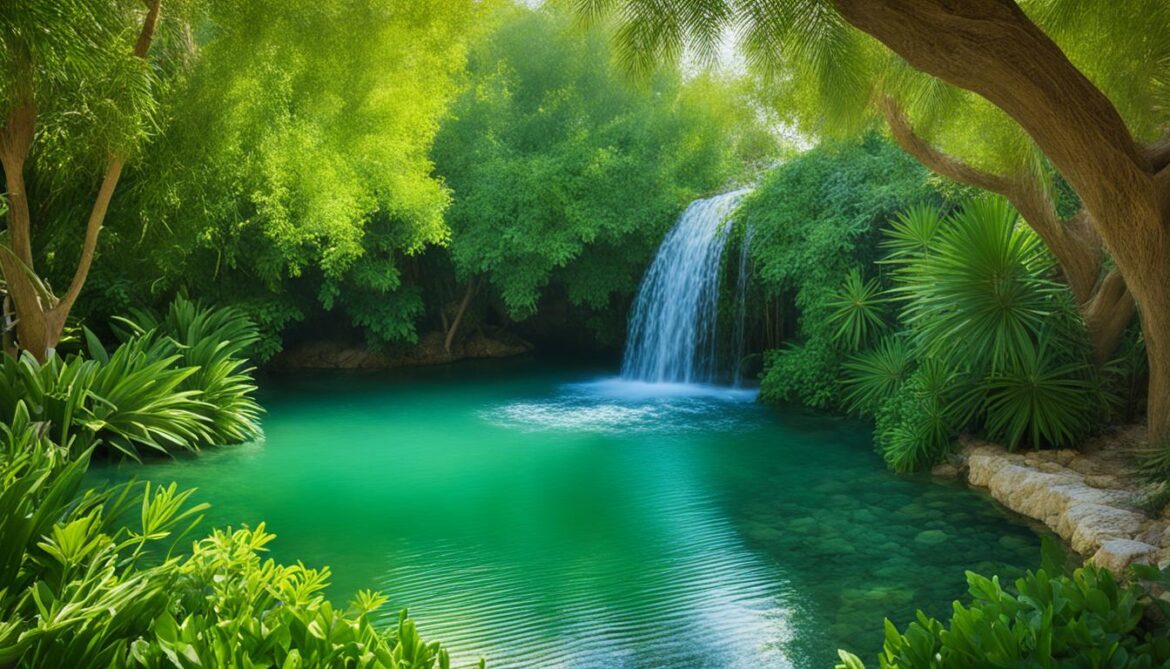
Legends Passed Down Through Generations
Over time, the tale of the Tree of Life has been passed down through generations, intertwining it with folklore and legends. These stories further fuel the sense of wonder surrounding the tree, enriching its cultural significance. The enduring nature of the Tree of Life has become a symbol of hope, resilience, and the power of nature’s miracles.
Visitors and Tourism
The Tree of Life in Bahrain has become one of the most sought-after tourist attractions in the country, attracting an impressive number of visitors each year. Approximately 65,000 tourists make their way to this iconic tree, eager to witness its timeless presence and the deep cultural significance it embodies.
The Tree of Life proudly showcases Bahrain’s rich cultural heritage and the natural beauty that the region has to offer. Amidst the arid desert landscape, this solitary tree stands as a testament to resilience and adaptability. It captivates visitors with its ability to thrive in such a challenging environment, demonstrating the harmony between nature and human existence.
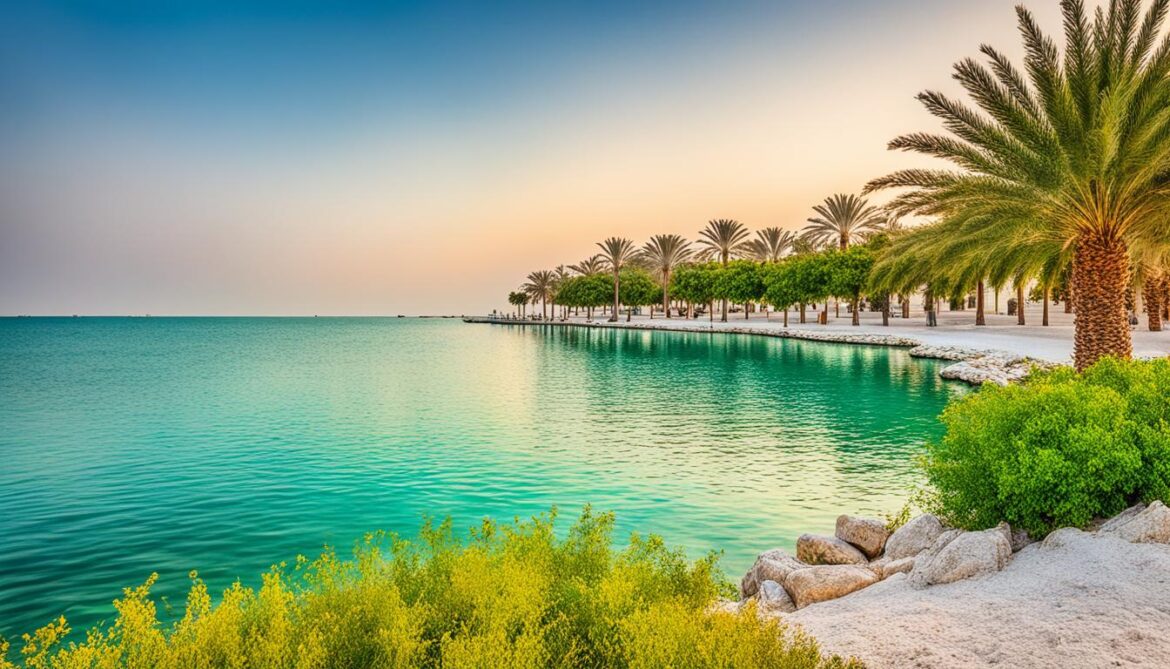
Visitors to Bahrain are in awe of the tree’s extraordinary survival, marveling at its lush foliage contrasting against the stark surroundings. It is a reminder of the intricacies of the natural world and the remarkable way in which life endures even in the harshest conditions.
Furthermore, the Tree of Life serves as a symbol of national pride, representing Bahrain’s commitment to preserving its cultural heritage and embracing the enchanting beauty of its natural surroundings. It is a source of inspiration and wonder, enticing both locals and tourists alike to explore the captivating allure of the country.
Conservation Challenges and Future Initiatives
The conservation of the Tree of Life and the overall biodiversity in Bahrain face several challenges. These challenges include urbanization, pollution, and the loss of natural habitats, which pose ongoing threats to environmental preservation. As Bahrain continues to develop and grow, it is essential to prioritize the protection of its natural resources and ecosystems.
“Conservation is a race against time. We must act now to safeguard our environment and preserve the unique biodiversity of Bahrain for future generations.”
To address these challenges, efforts are needed to develop effective management strategies and enact strict regulations that prioritize environmental preservation. It is crucial to prevent further ecosystem collapse and ensure the sustainable use of natural resources. By promoting responsible and sustainable practices, such as sustainable tourism, Bahrain can strike a balance between economic development and environmental conservation.
Promoting Sustainable Tourism
Sustainable tourism plays a vital role in preserving Bahrain’s biodiversity and natural heritage. By implementing sustainable tourism practices, we can minimize the negative impact on the environment and maximize the benefits to local communities. This includes promoting responsible tourism activities, developing eco-friendly infrastructure, and raising awareness among tourists about the importance of conservation.

Ensuring the long-term conservation of Bahrain’s biodiversity requires collaboration between stakeholders, including government agencies, local communities, and the tourism industry. By working together, we can develop initiatives that not only protect the natural environment but also provide opportunities for sustainable economic growth.
The Path Forward
To overcome the conservation challenges in Bahrain, future initiatives should focus on:
- Strengthening environmental regulations and enforcement to prevent habitat destruction and pollution.
- Investing in scientific research and monitoring to understand the impact of human activities on biodiversity.
- Expanding protected areas and implementing effective management plans.
- Improving public awareness and education on the importance of environmental preservation.
- Supporting sustainable agricultural practices and promoting the use of environmentally-friendly technologies.
By taking these steps, Bahrain can demonstrate its commitment to environmental conservation and contribute to global efforts in preserving biodiversity. The sustainable use of natural resources and responsible tourism practices will not only protect Bahrain’s unique ecosystems but also ensure a sustainable future for generations to come.
| Challenges | Conservation Efforts |
|---|---|
| Urbanization | Strengthening environmental regulations and land-use planning to minimize the impact of urban development on natural habitats. |
| Pollution | Implementing strict pollution control measures, promoting sustainable waste management practices, and raising awareness about the importance of pollution reduction. |
| Loss of natural habitats | Expanding the network of protected areas, creating wildlife corridors, and restoring degraded habitats to ensure the preservation of biodiversity. |
| Sustainable Tourism | Promoting responsible tourism practices, supporting eco-friendly infrastructure development, and educating tourists on the significance of environmental conservation. |
Conclusion
Bahrain’s biodiversity and sacred natural sites are not only a testament to the country’s cultural and natural heritage but also vital for environmental conservation. Protection measures, such as the establishment of protected areas and promoting sustainable use of biodiversity, play a crucial role in preserving these unique ecosystems. By raising awareness and implementing effective measures, Bahrain can ensure the long-term conservation of its biodiversity and safeguard the natural wonders that make the country a truly remarkable destination.




